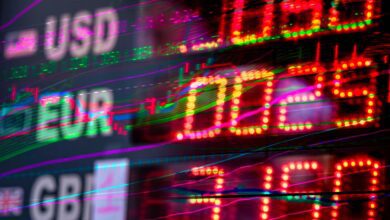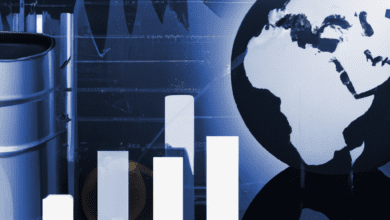Currency Under Pressure: Navigating Interest Rates, Geopolitics, and Digital Trends in Forex Markets

In the complex and ever-evolving landscape of foreign exchange (forex) trading, understanding the myriad factors that influence currency values is essential for both novice and seasoned traders alike. Interest rates, geopolitical events, and central bank policies serve as pivotal forces that shape currency dynamics and impact trading strategies. This article delves into the intricate connection between interest rates and currency exchange rates, exploring how fluctuations in these rates can lead to significant shifts in forex markets. Additionally, we will examine the influence of geopolitical events on currency movements, the critical role of central banks in establishing monetary policy, and the effects of inflation on trading decisions. As we navigate the intricacies of major currency pairs like EUR/USD and GBP/USD, we will also touch on innovative strategies such as carry trading, which capitalizes on interest rate differentials, and the rise of digital currencies that challenge traditional forex paradigms. By leveraging economic indicators to predict currency movements, traders can enhance their understanding of the market and make informed decisions in this dynamic environment. Join us as we unravel the complexities of currency trading and equip you with the insights necessary to thrive in the forex market.
- 1. **Interest Rates and Currency Dynamics: Understanding the Connection**
- 2. **Geopolitical Influences on Forex: Navigating Uncertainty in Currency Markets**
1. **Interest Rates and Currency Dynamics: Understanding the Connection**
Interest rates play a crucial role in determining currency exchange rates, primarily through their influence on capital flows and investor sentiment. When a country's central bank raises interest rates, it typically leads to an appreciation of that country's currency. Higher interest rates offer better returns on investments denominated in that currency, attracting foreign capital and increasing demand. Conversely, when interest rates are lowered, the currency may depreciate as investments yield less attractive returns, prompting investors to seek better opportunities elsewhere.
The relationship between interest rates and currency values is also influenced by expectations of future monetary policy. If investors anticipate that a central bank will increase rates in the future, this can lead to currency appreciation even before the actual rate hike occurs. Market participants often react to signals from central banks, such as statements or economic forecasts, which can cause fluctuations in currency values based on perceived future interest rate changes.
Additionally, interest rates affect inflation expectations, which in turn influence currency dynamics. A country with rising interest rates may signal to investors that it is taking measures to control inflation, thereby strengthening its currency. In contrast, if a country is perceived to have persistently low interest rates alongside rising inflation, its currency may weaken as purchasing power declines.
In summary, understanding the connection between interest rates and currency dynamics is vital for traders and investors in the forex market. By monitoring central bank policies and economic indicators, market participants can gain insights into potential currency movements, allowing them to make informed trading decisions.
Interest rates play a crucial role in shaping currency exchange rates, influencing both short-term trading decisions and long-term economic trends. When a central bank adjusts interest rates, it typically leads to a corresponding change in the value of that country's currency. Higher interest rates tend to attract foreign capital seeking better returns, increasing demand for the currency and causing it to appreciate. Conversely, lower interest rates can lead to depreciation as capital flows out in search of higher yields elsewhere.
Geopolitical events, such as elections, trade negotiations, and conflicts, can further complicate the forex landscape. For instance, political instability in a country may result in decreased investor confidence, leading to currency depreciation. Conversely, positive geopolitical developments, such as successful trade agreements, can bolster a currency's value. Traders often monitor geopolitical news closely, as these events can trigger rapid shifts in market sentiment and currency values.
When trading major currency pairs like EUR/USD and GBP/USD, understanding the interplay between interest rates and geopolitical events is essential. Traders may employ various strategies, including technical analysis and fundamental analysis, to navigate these markets effectively. For instance, they might analyze economic indicators, such as inflation rates and employment figures, to gauge potential shifts in monetary policy that could impact interest rates and, subsequently, exchange rates.
Central banks are key players in this dynamic, as their policies directly influence currency values. Decisions made by the Federal Reserve, the European Central Bank, and other central banks regarding interest rates and monetary policy can lead to significant market volatility. Traders must stay informed about central bank announcements and economic reports to anticipate potential currency movements.
Inflation is another critical factor affecting forex trading strategies. High inflation can erode purchasing power and lead central banks to raise interest rates, impacting currency values. Traders often adjust their strategies based on inflation expectations, using indicators such as the Consumer Price Index (CPI) to inform their decisions.
Carry trading, which involves borrowing in a currency with a low interest rate and investing in a currency with a higher interest rate, has gained popularity as a strategy to profit from interest rate differentials. This strategy can be lucrative, especially in stable economic conditions, but it carries risks, particularly during periods of market volatility or geopolitical uncertainty.
The rise of digital currencies is also reshaping traditional forex markets. As cryptocurrencies gain acceptance and regulatory frameworks evolve, traders must consider how these assets interact with fiat currencies. The volatility of digital currencies can present both opportunities and challenges for forex traders, necessitating a nuanced approach to risk management and strategy development.
Economic indicators, such as GDP growth, unemployment rates, and trade balances, are vital tools for predicting currency movements. Traders analyze these indicators to identify trends and potential market shifts, allowing them to make informed decisions in a rapidly changing environment. Understanding the broader economic landscape and keeping an eye on key indicators can enhance trading strategies and improve the chances of success in the forex market.
2. **Geopolitical Influences on Forex: Navigating Uncertainty in Currency Markets**
Geopolitical events play a significant role in influencing forex markets, often introducing volatility and uncertainty that can lead to rapid changes in currency values. Factors such as political instability, military conflicts, trade negotiations, and diplomatic relations can all impact investor sentiment and, consequently, the demand for various currencies.
When geopolitical tensions arise, safe-haven currencies like the US dollar, Swiss franc, and Japanese yen often appreciate as investors seek to minimize risk. For instance, during periods of uncertainty, such as the Brexit negotiations or heightened tensions in the Middle East, traders may flock to these currencies, driving their value up against more vulnerable counterparts. Conversely, currencies from countries experiencing political unrest may depreciate as confidence in their economic stability wanes.
Additionally, geopolitical events can lead to changes in monetary policy, as central banks may respond to emerging crises with adjustments in interest rates or other economic measures. For example, if a country faces significant unrest, its central bank might lower interest rates to stimulate the economy, which can further devalue its currency in the forex market.
Trade agreements and tariffs also have considerable implications for currency exchange rates. For example, announcements regarding new trade deals can strengthen the currencies of the countries involved, while the imposition of tariffs may lead to depreciation. Forex traders must remain vigilant about geopolitical news, as swift reactions to developments can create trading opportunities or risks.
In summary, navigating the complexities of geopolitical influences on forex requires an understanding of how these events shape market sentiment and economic policies. Successful forex traders need to continuously monitor global developments, as the interplay between geopolitical factors and currency values is dynamic and often unpredictable.
In conclusion, the intricate relationship between interest rates, geopolitical events, and currency exchange rates underscores the complexity of the forex market. As we have explored, interest rates serve as a primary driver of currency values, influencing trading strategies and investor behavior. Geopolitical events introduce additional layers of unpredictability, often leading to rapid shifts in market sentiment that can significantly impact currency pairs like EUR/USD and GBP/USD.
Central banks play a pivotal role in this dynamic, as their monetary policies dictate interest rate adjustments that ripple through the forex landscape. Additionally, inflation remains a critical factor, shaping trading strategies and market expectations. The rise of digital currencies brings a new dimension to forex trading, challenging traditional paradigms while offering opportunities for innovative strategies, such as carry trading, which capitalizes on interest rate differentials.
Ultimately, successful forex trading requires a comprehensive understanding of economic indicators and their predictive power regarding currency movements. By integrating these elements into their strategies, traders can navigate the complexities of the forex market with greater confidence. As we look to the future, staying informed about these factors will be essential for making sound trading decisions in an ever-evolving financial landscape.





